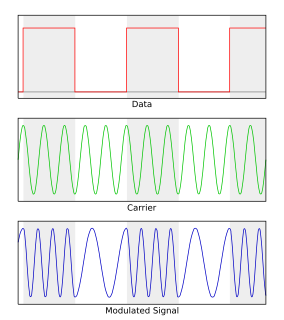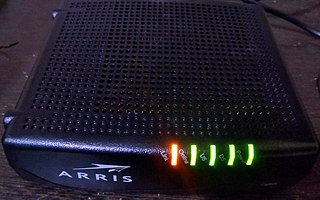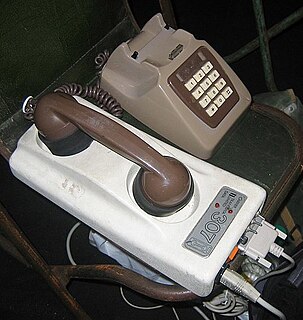
In telecommunications and signal processing, frequency modulation (FM) is the encoding of information in a carrier wave by varying the instantaneous frequency of the wave.

Packet radio is a digital radio communications mode used to send packets of data. Packet radio uses packet switching to transmit datagrams. This is very similar to how packets of data are transferred between nodes on the Internet. Packet radio can be used to transmit data long distances.

Radioteletype (RTTY) is a telecommunications system consisting originally of two or more electromechanical teleprinters in different locations connected by radio rather than a wired link. These machines were superseded by personal computers (PCs) running software to emulate teleprinters. Radioteletype evolved from earlier landline teleprinter operations that began in the mid-1800s. The US Navy Department successfully tested printing telegraphy between an airplane and ground radio station in 1922. Later that year, the Radio Corporation of America successfully tested printing telegraphy via their Chatham, Massachusetts, radio station to the R.M.S. Majestic. Commercial RTTY systems were in active service between San Francisco and Honolulu as early as April 1932 and between San Francisco and New York City by 1934. The US military used radioteletype in the 1930s and expanded this usage during World War II. From the 1980s, teleprinters were replaced by computers running teleprinter emulation software.

Frequency-shift keying (FSK) is a frequency modulation scheme in which digital information is transmitted through discrete frequency changes of a carrier signal. The technology is used for communication systems such as telemetry, weather balloon radiosondes, caller ID, garage door openers, and low frequency radio transmission in the VLF and ELF bands. The simplest FSK is binary FSK (BFSK). BFSK uses a pair of discrete frequencies to transmit binary information. With this scheme, the "1" is called the mark frequency and the "0" is called the space frequency.
In telecommunication, signaling is the use of signals for controlling communications. This may constitute an information exchange concerning the establishment and control of a telecommunication circuit and the management of the network—in contrast to manual setup of circuits by users or administrators, for example the sending of a signal from the transmitting end of a telecommunication circuit to inform a user at the receiving end that a message is to be sent.

A cable modem is a type of network bridge that provides bi-directional data communication via radio frequency channels on a hybrid fibre-coaxial (HFC), radio frequency over glass (RFoG) and coaxial cable infrastructure. Cable modems are primarily used to deliver broadband Internet access in the form of cable Internet, taking advantage of the high bandwidth of a HFC and RFoG network. They are commonly deployed in the Americas, Asia, Australia, and Europe.
Phreaking is a slang term coined to describe the activity of a culture of people who study, experiment with, or explore telecommunication systems, such as equipment and systems connected to public telephone networks. The term phreak is a sensational spelling of the word freak with the ph- from phone, and may also refer to the use of various audio frequencies to manipulate a phone system. Phreak, phreaker, or phone phreak are names used for and by individuals who participate in phreaking.

A blue box is an electronic device that generates the in-band signaling tones formerly generated by telephone operator consoles to control telephone switches.
Call waiting is a telecommunication service offered by a telephone service provider to a subscriber by which the subscriber may suspend a telephone call already in progress to accept a second call. The subscriber may switch between calls, typically by using the hook flash signal.
B channel (bearer) is a telecommunications term which refers to the ISDN channel in which the primary data or voice communication is carried. It has a bit rate of 64 kbit/s in full duplex.
Guard tone is a feature of wireline modems.
The V.23 standard was an early modem standard approved by the ITU in 1988. It specifies audio frequency-shift keying (AFSK) to encode and transfer data at a rate of 1200 bits per second, half-duplex at 1200 baud (Mode 2), (or at a "fallback rate" of 600 baud, mode 1) for the forward data-transmission channel, and an optional 75 baud backward channel.
The Bell 103 modem or Bell 103 dataset was the second commercial modem for computers, released by AT&T Corporation in 1962. It allowed digital data to be transmitted over regular unconditioned telephone lines at a speed of 300 bits per second. It followed the introduction of the 110 baud Bell 101 dataset in 1958.
In digital communications, symbol rate, also known as baud rate and modulation rate, is the number of symbol changes, waveform changes, or signaling events, across the transmission medium per time unit using a digitally modulated signal or a line code. The symbol rate is measured in baud (Bd) or symbols per second. In the case of a line code, the symbol rate is the pulse rate in pulses per second. Each symbol can represent or convey one or several bits of data. The symbol rate is related to the gross bitrate expressed in bits per second.

A digital subscriber line (DSL) modem is a device used to connect a computer or router to a telephone line which provides the digital subscriber line service for connection to the Internet, which is often called DSL broadband.
Hearing range describes the range of frequencies that can be heard by humans or other animals, though it can also refer to the range of levels. The human range is commonly given as 20 to 20,000 Hz, although there is considerable variation between individuals, especially at high frequencies, and a gradual loss of sensitivity to higher frequencies with age is considered normal. Sensitivity also varies with frequency, as shown by equal-loudness contours. Routine investigation for hearing loss usually involves an audiogram which shows threshold levels relative to a normal.

NO CARRIER (capitalized) is a text message transmitted from a modem to its attached device, indicating the modem is not connected to a remote system.
In telecommunications, echo is the local display of data, either initially as it is locally sourced and sent, or finally as a copy of it is received back from a remote destination. Local echo is where the local sending equipment displays the outgoing sent data. Remote echo is where the display is a return copy of data as received remotely. Both are used together in a computed form of error detection to ensure that data received at the remote destination of a telecommunication are the same as data sent from the local source. When (two) modems communicate in echoplex mode the remote modem echoes whatever it receives from the local modem.

A modem is a hardware device that converts data into a format suitable for a transmission medium so that it can be transmitted from computer to computer. A modem modulates one or more carrier wave signals to encode digital information for transmission and demodulates signals to decode the transmitted information. The goal is to produce a signal that can be transmitted easily and decoded reliably to reproduce the original digital data. Modems can be used with almost any means of transmitting analog signals from light-emitting diodes to radio. A common type of modem is one that turns the digital data of a computer into modulated electrical signal for transmission over telephone lines and demodulated by another modem at the receiver side to recover the digital data.
Echo suppression and echo cancellation are methods used in telephony to improve voice quality by preventing echo from being created or removing it after it is already present. In addition to improving subjective audio quality, echo suppression increases the capacity achieved through silence suppression by preventing echo from traveling across a network. Echo suppressors were developed in the 1950s in response to the first use of satellites for telecommunications, but they have since been largely supplanted by better performing echo cancellers.











